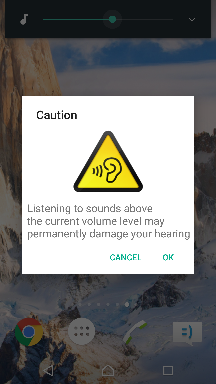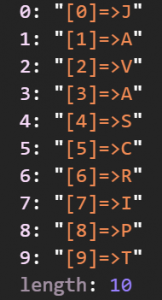介绍
有时,当您将耳机与Android设备配合使用时,媒体音量可能会突然下降,并且无法将音量调高。为此,您必须解锁设备并接受警告:

对话框出现的时间是无法预测的:当您开车或骑自行车,手脏或弄湿等时,可能会出现该对话框。当然,通过耳机听大声的音乐可能会损害听力。但是设备无法识别所连接的设备:耳机或扬声器。对于演讲者来说,此消息毫无意义。
为什么会出现
听力系统有WHO-ETU标准。在欧盟和其他一些国家/地区,必须强制使用它们。这些标准根据音量和收听时间来描述人们的声音容限。
如何在Android中实现
根据MCC(移动国家/地区代码),可以启用或禁用警告。它由资源定义R.bool.config_safe_media_volume_enabled。如果启用了警告,则系统会计算“不安全的收听”时间,并在达到20小时后显示警告。
当音量大于85 dB且连接了耳机时,则认为收听“不安全”。累积的“不安全收听”时间存储在其中,Settings.Secure.UNSAFE_VOLUME_MUSIC_ACTIVE_MS并每分钟更新一次。
安全监听系统逻辑在AudioService.java中实现。
根目录设备的解决方法
设置audio.safemedia.bypass=true在文件系统/ build.properties:
为什么它应该起作用?
让我们看一下AudioService.java中的一些字段:
// mSafeMediaVolumeState indicates whether the media volume is limited over headphones. // It is SAFE_MEDIA_VOLUME_NOT_CONFIGURED at boot time until a network service is connected // or the configure time is elapsed. It is then set to SAFE_MEDIA_VOLUME_ACTIVE or // SAFE_MEDIA_VOLUME_DISABLED according to country option. If not SAFE_MEDIA_VOLUME_DISABLED, // it can be set to SAFE_MEDIA_VOLUME_INACTIVE by calling AudioService.disableSafeMediaVolume() // (when user opts out). private static final int SAFE_MEDIA_VOLUME_NOT_CONFIGURED = 0; private static final int SAFE_MEDIA_VOLUME_DISABLED = 1; private static final int SAFE_MEDIA_VOLUME_INACTIVE = 2; // confirmed private static final int SAFE_MEDIA_VOLUME_ACTIVE = 3; // unconfirmed private Integer mSafeMediaVolumeState;
该字段mSafeMediaVolumeState 保持当前的安全监听状态:
- DISABLED:禁用安全监听(音量级别不受控制)
- ACTIVE:启用了安全监听,“不安全监听”时间已达到20小时,用户必须确认对话框才能提高音量
- INACTIVE:启用了安全监听,“不安全监听”时间尚未达到20小时
我们需要mSafeMediaVolumeState 分配给DISABLED。
初始值在这里分配:
private void onConfigureSafeVolume(boolean force, String caller) {
...
boolean safeMediaVolumeEnabled =
SystemProperties.getBoolean("audio.safemedia.force", false)
|| mContext.getResources().getBoolean(
com.android.internal.R.bool.config_safe_media_volume_enabled);
boolean safeMediaVolumeBypass =
SystemProperties.getBoolean("audio.safemedia.bypass", false);
int persistedState;
if (safeMediaVolumeEnabled && !safeMediaVolumeBypass) {
persistedState = SAFE_MEDIA_VOLUME_ACTIVE;
/* Omitted code. Here mSafeMediaVolumeState is assigned to ACTIVE, or INACTIVE */
...
} else {
persistedState = SAFE_MEDIA_VOLUME_DISABLED;
mSafeMediaVolumeState = SAFE_MEDIA_VOLUME_DISABLED;
}
DISABLED在两种情况下,可以将其分配给:什么时候R.bool.config_safe_media_volume_enabled=true(我们不能更改)或什么时候audio.safemedia.bypass = true(我们可以使用root特权进行更改)。
无根的解决方法
解决方案是监视的值,Settings.Secure.UNSAFE_VOLUME_MUSIC_ACTIVE_MS并且不允许其超过20小时。接近阈值时应重置该值。
如何读取当前值
int unsafeMs = Settings.Secure.getInt(contentResolver, "unsafe_volume_music_active_ms")
使用adb相同
adb shell settings get secure unsafe_volume_music_active_ms
如何更新价值
首先,授予更改安全设置的权限:
adb shell pm grant com.example.app android.permission.WRITE_SECURE_SETTINGS
可以完成,因为此许可权具有“,”, 然后调用:protectionLevel="signature|privileged|development
Settings.Secure.putInt(contentResolver, "unsafe_volume_music_active_ms" , 1)
它必须为1,因为0值与ACTIVE状态相关联。
使用adb也是一样:
adb shell settings put secure unsafe_volume_music_active_ms 1
值更新后,我们需要让AudioService读取并使用它。根据源代码,唯一的方法是重新启动它。音频服务是一项系统服务,因此要重新启动它,必须重新启动设备(或者用户可以重新登录)。
为了使该解决方案更易于使用,我为一个小型应用程序编写了代码,该应用程序会定期检查该Settings.Secure.UNSAFE_VOLUME_MUSIC_ACTIVE_MS值并提醒重新启动设备。
当然,重新启动或重新登录需要花费时间,但是此解决方案不需要root特权。
如何在Android上禁用大容量警告消息 转载https://www.codesocang.com/appboke/46140.html
热门源码











